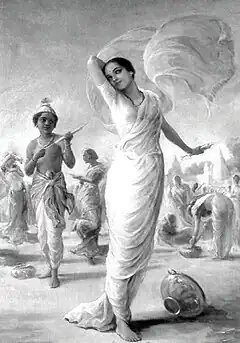Ranga Panchami
Ranga Panchami (Sanskrit: रंगपंचमी, romanized: Raṅgapañcamī) is a Hindu festival celebrated on Phalguna Krishna Paksha Panchami, which is the fifth day[1] of the second fortnight of the Hindu month of Phalguna. It is marked on the fifth day following the festival of Holi.[2]
| Ranga Panchami | |
|---|---|
 20th century painting depicting the festival | |
| Observed by | Hindus |
| Type | Hinduism |
| Significance | Arrival of spring, the love of Radha and Krishna, the salvation of Prahlada |
| Celebrations | Spraying of colours, prayer, pujas |
| Date | 12 March (2023) |
| Related to | Holi |
During Ranga Panchami, people sprinkle or smear colored powder on each other, similar to Holi. However, unlike Holi, on Ranga Panchami, people also splash colored water on each other. The festival is believed to have originated in Maharashtra and is also known as Shigmo.[3] In some places, people make small processions carrying an image of a deity, and the procession ends with the immersion of the deity in a nearby river or pond.
Ranga Panchami is a popular festival in Madhya Pradesh, Maharashtra, and Karnataka.
Etymology
The word "ranga" means colour, and "panchami" refers to the fifth day in the Hindu month.
Description
Ranga Panchami is celebrated as a festival of love and colour, associated with the divine couple Radha Krishna. According to another legend it shares with Holi, it is regarded to mark the event of the salvation of Prahlada from a bonfire lit by his aunt Holika, the sister of the asura king Hiranyakashipu.[4]
References
- Verma, Rajeev (2009). Faith & Philosophy of Hinduism. Gyan Publishing House. p. 255. ISBN 978-81-7835-718-8.
- Galván, Javier A. (2014-06-19). They Do What?: A Cultural Encyclopedia of Extraordinary and Exotic Customs from around the World. Bloomsbury Publishing USA. p. 139. ISBN 978-1-61069-342-4.
- Bhatt, S. C. (2005). Land and people of Indian states and union territories : (in 36 volumes). Gyan Publishing House. p. 232. ISBN 978-81-7835-356-2.
- Greenberg, Yudit Kornberg (2007-11-15). Encyclopedia of Love in World Religions [2 volumes]: [2 volumes]. Bloomsbury Publishing USA. p. 212. ISBN 978-1-85109-981-8.
